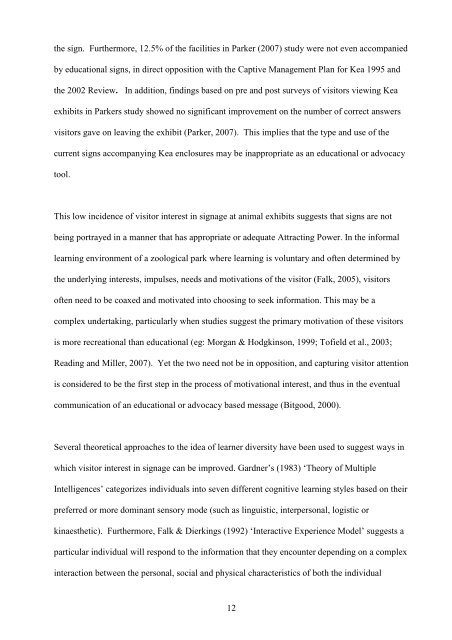The Dynamics of Kea Behaviour and Interpretive Signage on Visitor ...
The Dynamics of Kea Behaviour and Interpretive Signage on Visitor ...
The Dynamics of Kea Behaviour and Interpretive Signage on Visitor ...
Create successful ePaper yourself
Turn your PDF publications into a flip-book with our unique Google optimized e-Paper software.
the sign. Furthermore, 12.5% <str<strong>on</strong>g>of</str<strong>on</strong>g> the facilities in Parker (2007) study were not even accompanied<br />
by educati<strong>on</strong>al signs, in direct oppositi<strong>on</strong> with the Captive Management Plan for <str<strong>on</strong>g>Kea</str<strong>on</strong>g> 1995 <str<strong>on</strong>g>and</str<strong>on</strong>g><br />
the 2002 Review. In additi<strong>on</strong>, findings based <strong>on</strong> pre <str<strong>on</strong>g>and</str<strong>on</strong>g> post surveys <str<strong>on</strong>g>of</str<strong>on</strong>g> visitors viewing <str<strong>on</strong>g>Kea</str<strong>on</strong>g><br />
exhibits in Parkers study showed no significant improvement <strong>on</strong> the number <str<strong>on</strong>g>of</str<strong>on</strong>g> correct answers<br />
visitors gave <strong>on</strong> leaving the exhibit (Parker, 2007). This implies that the type <str<strong>on</strong>g>and</str<strong>on</strong>g> use <str<strong>on</strong>g>of</str<strong>on</strong>g> the<br />
current signs accompanying <str<strong>on</strong>g>Kea</str<strong>on</strong>g> enclosures may be inappropriate as an educati<strong>on</strong>al or advocacy<br />
tool.<br />
This low incidence <str<strong>on</strong>g>of</str<strong>on</strong>g> visitor interest in signage at animal exhibits suggests that signs are not<br />
being portrayed in a manner that has appropriate or adequate Attracting Power. In the informal<br />
learning envir<strong>on</strong>ment <str<strong>on</strong>g>of</str<strong>on</strong>g> a zoological park where learning is voluntary <str<strong>on</strong>g>and</str<strong>on</strong>g> <str<strong>on</strong>g>of</str<strong>on</strong>g>ten determined by<br />
the underlying interests, impulses, needs <str<strong>on</strong>g>and</str<strong>on</strong>g> motivati<strong>on</strong>s <str<strong>on</strong>g>of</str<strong>on</strong>g> the visitor (Falk, 2005), visitors<br />
<str<strong>on</strong>g>of</str<strong>on</strong>g>ten need to be coaxed <str<strong>on</strong>g>and</str<strong>on</strong>g> motivated into choosing to seek informati<strong>on</strong>. This may be a<br />
complex undertaking, particularly when studies suggest the primary motivati<strong>on</strong> <str<strong>on</strong>g>of</str<strong>on</strong>g> these visitors<br />
is more recreati<strong>on</strong>al than educati<strong>on</strong>al (eg: Morgan & Hodgkins<strong>on</strong>, 1999; T<str<strong>on</strong>g>of</str<strong>on</strong>g>ield et al., 2003;<br />
Reading <str<strong>on</strong>g>and</str<strong>on</strong>g> Miller, 2007). Yet the two need not be in oppositi<strong>on</strong>, <str<strong>on</strong>g>and</str<strong>on</strong>g> capturing visitor attenti<strong>on</strong><br />
is c<strong>on</strong>sidered to be the first step in the process <str<strong>on</strong>g>of</str<strong>on</strong>g> motivati<strong>on</strong>al interest, <str<strong>on</strong>g>and</str<strong>on</strong>g> thus in the eventual<br />
communicati<strong>on</strong> <str<strong>on</strong>g>of</str<strong>on</strong>g> an educati<strong>on</strong>al or advocacy based message (Bitgood, 2000).<br />
Several theoretical approaches to the idea <str<strong>on</strong>g>of</str<strong>on</strong>g> learner diversity have been used to suggest ways in<br />
which visitor interest in signage can be improved. Gardner’s (1983) ‘<str<strong>on</strong>g>The</str<strong>on</strong>g>ory <str<strong>on</strong>g>of</str<strong>on</strong>g> Multiple<br />
Intelligences’ categorizes individuals into seven different cognitive learning styles based <strong>on</strong> their<br />
preferred or more dominant sensory mode (such as linguistic, interpers<strong>on</strong>al, logistic or<br />
kinaesthetic). Furthermore, Falk & Dierkings (1992) ‘Interactive Experience Model’ suggests a<br />
particular individual will resp<strong>on</strong>d to the informati<strong>on</strong> that they encounter depending <strong>on</strong> a complex<br />
interacti<strong>on</strong> between the pers<strong>on</strong>al, social <str<strong>on</strong>g>and</str<strong>on</strong>g> physical characteristics <str<strong>on</strong>g>of</str<strong>on</strong>g> both the individual<br />
12












